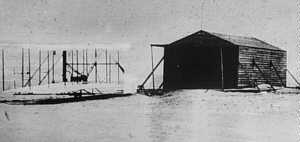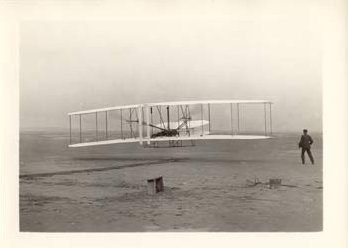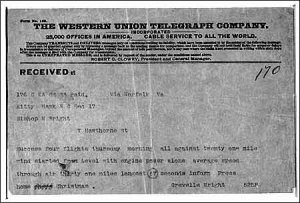The Flyer lifts off from Kitty Hawk
 There was a lot to
do that winter! They needed a petrol (gasoline) engine, but the problem was: all
existing engines were far too heavy because they were only built for the first
motorcars. Well, they decided to design an engine themselves. Within six weeks
they built an engine, together with their fantastic mechanic CharlieTaylor.
There was a lot to
do that winter! They needed a petrol (gasoline) engine, but the problem was: all
existing engines were far too heavy because they were only built for the first
motorcars. Well, they decided to design an engine themselves. Within six weeks
they built an engine, together with their fantastic mechanic CharlieTaylor.
Its weight was 63 kilograms and delivered 12 horsepower. A rather good
achievement.
Then they needed two propellers to propel the
aeroplane. Until now, propellers looked like little flat scoops, but Wilbur and
Orville were convinced a propeller should look more like a kind of wing. They did a lot
of calculating and then they made propellers of two layers of wood glued
together. The wood was scraped in the right shape and look, the modern propeller
was born! Because they owned a bicycle factory, they chose a bicycle chain
as a drive.
On the 25th of September 1903 they returned to Kitty Hawk. The brothers were in a hurry because they wanted to be the first to
really fly. The only other person capable of doing so, was professor Langley.
Langley had learned from a lecture Wilbur had given a few years before. Now the
brothers decided to keep their experiments secret.
Their new aeroplane was called "Flyer".
It's weight was 272 kilos. Much heavier than their earlier planes. For takeoff it was placed on a wooden rail of 18 meters length.With help of people
from the village the Flyer was pushed along the rail. But again... setbacks
occurred. The
engine did not run well, propellers detached and damaged the Flyer. After the
repairs problems with the propeller shafts arose.
 Meanwhile professor
Langley was busy too. Amid great public interest he launched his aeroplane off a
rail on a houseboat. Immediately afterwards it plunged into the water. The
machine had not flown and the papers wrote about a ridiculous display, staging that
it would take a long time before man could fly in an aeroplane.
Meanwhile professor
Langley was busy too. Amid great public interest he launched his aeroplane off a
rail on a houseboat. Immediately afterwards it plunged into the water. The
machine had not flown and the papers wrote about a ridiculous display, staging that
it would take a long time before man could fly in an aeroplane.
For the Wrights, December was plagued with problems too. Last but
not least the weather ruined the trials too. But at last the Great Day arrived!
In the morning of December 17th 1903 the Flyer,
with Orville on the controls, lifted off from the rail and flew a distance of 30
meters at a height of three meters. The flight was short, but historic.
"This was the first time in history a manned aeroplane took off on it's
own power, flew without losing speed and had landed at a point that was at the
same height as the point of departure".
That morning they flew another three times. During
the last flight Wilbur covered a distance of 256 meters and stayed airborne for
59 seconds. Immediately afterwards he landed very hard and the Flyer was
damaged. There were witnesses from Kitty Hawk and the brothers sent a telegram
to their father. Aviation had started!
 |
 |
| The first flight |
The telegram |
 In 1904 the brothers
did not need the hard wind and soft sand of Kitty Hawk any longer. On a field
behind a farm in Dayton they built a wooden hangar and in the summer of the same
year they made flights of 390 to 420 meters with the "Flyer II". In
September they built a start installation with a weight in a tower and a rope. In this way they could pull the Flyer with great speed along the
rail (at left you can see the tower). Its like the modern catapult on
board an aircraft carrier. The Wrights gained a lot of experience in flying and
controlling the aeroplane. On September 20th Wilbur made history by flying a full
circle in the air. He covered a distance of 1300 meters in one minute and 35 seconds.
In 1904 the brothers
did not need the hard wind and soft sand of Kitty Hawk any longer. On a field
behind a farm in Dayton they built a wooden hangar and in the summer of the same
year they made flights of 390 to 420 meters with the "Flyer II". In
September they built a start installation with a weight in a tower and a rope. In this way they could pull the Flyer with great speed along the
rail (at left you can see the tower). Its like the modern catapult on
board an aircraft carrier. The Wrights gained a lot of experience in flying and
controlling the aeroplane. On September 20th Wilbur made history by flying a full
circle in the air. He covered a distance of 1300 meters in one minute and 35 seconds.
The following year Orville and Wilbur made ever longer flights. On October 5th
they even made a flight of 38,7 km distance in 38 minutes. If they had not run
out of fuel, the flight could have lasted even longer.
The following years the brothers performed
displays in the USA and Europe.
The American Army bought Wright aeroplanes and in September 1908 Orville broke
different records during a demonstration for the military: a flight of 62
minutes, with 57 complete circles at a height of 37 meters. They became
world-famous.
Orville and Wilbur Wright contributed more to
aviation then all researchers before them. Their research was very
important for all the aviation pioneers who started after them. The
aeroplane was an invention to stay and after the brothers, development went very
fast. Wilbur did not live to see it all because he died in 1912. Orville lived
until 1948 and lived to see the enormous development of the aeroplane.
 There was a lot to
do that winter! They needed a petrol (gasoline) engine, but the problem was: all
existing engines were far too heavy because they were only built for the first
motorcars. Well, they decided to design an engine themselves. Within six weeks
they built an engine, together with their fantastic mechanic CharlieTaylor.
There was a lot to
do that winter! They needed a petrol (gasoline) engine, but the problem was: all
existing engines were far too heavy because they were only built for the first
motorcars. Well, they decided to design an engine themselves. Within six weeks
they built an engine, together with their fantastic mechanic CharlieTaylor.
 Meanwhile professor
Langley was busy too. Amid great public interest he launched his aeroplane off a
rail on a houseboat. Immediately afterwards it plunged into the water. The
machine had not flown and the papers wrote about a ridiculous display, staging that
it would take a long time before man could fly in an aeroplane.
Meanwhile professor
Langley was busy too. Amid great public interest he launched his aeroplane off a
rail on a houseboat. Immediately afterwards it plunged into the water. The
machine had not flown and the papers wrote about a ridiculous display, staging that
it would take a long time before man could fly in an aeroplane.

 In 1904 the brothers
did not need the hard wind and soft sand of Kitty Hawk any longer. On a field
behind a farm in Dayton they built a wooden hangar and in the summer of the same
year they made flights of 390 to 420 meters with the "Flyer II". In
September they built a start installation with a weight in a tower and a rope. In this way they could pull the Flyer with great speed along the
rail (at left you can see the tower). Its like the modern catapult on
board an aircraft carrier. The Wrights gained a lot of experience in flying and
controlling the aeroplane. On September 20th Wilbur made history by flying a full
circle in the air. He covered a distance of 1300 meters in one minute and 35 seconds.
In 1904 the brothers
did not need the hard wind and soft sand of Kitty Hawk any longer. On a field
behind a farm in Dayton they built a wooden hangar and in the summer of the same
year they made flights of 390 to 420 meters with the "Flyer II". In
September they built a start installation with a weight in a tower and a rope. In this way they could pull the Flyer with great speed along the
rail (at left you can see the tower). Its like the modern catapult on
board an aircraft carrier. The Wrights gained a lot of experience in flying and
controlling the aeroplane. On September 20th Wilbur made history by flying a full
circle in the air. He covered a distance of 1300 meters in one minute and 35 seconds.